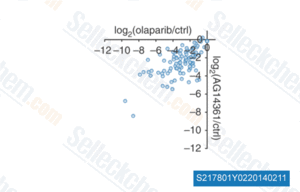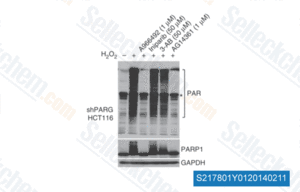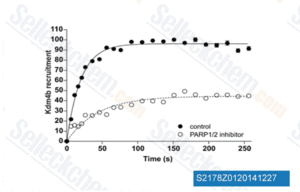|
Toll Free: (877) 796-6397 -- USA and Canada only -- |
Fax: +1-832-582-8590 Orders: +1-832-582-8158 |
Tech Support: +1-832-582-8158 Ext:3 Please provide your Order Number in the email. |
Technical Data
| Formula | C19H20N4O |
||||||
| Molecular Weight | 320.39 | CAS No. | 328543-09-5 | ||||
| Solubility (25°C)* | In vitro | DMSO | 12 mg/mL (37.45 mM) | ||||
| Water | Insoluble | ||||||
| Ethanol | Insoluble | ||||||
| In vivo (Add solvents to the product individually and in order) |
|
||||||
|
* <1 mg/ml means slightly soluble or insoluble. * Please note that Selleck tests the solubility of all compounds in-house, and the actual solubility may differ slightly from published values. This is normal and is due to slight batch-to-batch variations. * Room temperature shipping (Stability testing shows this product can be shipped without any cooling measures.) |
|||||||
Preparing Stock Solutions
Biological Activity
| Description | AG14361 is a potent inhibitor of PARP1 with Ki of <5 nM in a cell-free assay. It is at least 1000-fold more potent than the benzamides. | ||
|---|---|---|---|
| Targets |
|
||
| In vitro | AG14361 is at least 1000-fold more potent than the benzamides. The IC50 for AG14361 is 29 nM in permeabilized SW620 cells and 14 nM in intact SW620 cells. Crystallographic analysis of AG14361 bound to the catalytic domain of chicken PARP-1 shows that the tricyclic ring system of AG14361 is located in a pocket composed of amino acid residues Trp861, His862, Gly863, Tyr896, Phe897, Ala898, Lys903, Ser904, Tyr907, and Glu988. AG14361 forms important hydrogen bonds with Ser904 and Gly863 and a water-mediated hydrogen bond with Glu988. AG14361-induced growth inhibition is not attributed to PARP-1-related effects because maximal PARP-1 inhibition is observed at much lower concentrations (≤1 μM) than the GI50. AG14361 at 0.4 μM does not affect cancer cell gene expression or growth, but it increases the antiproliferative activity, and inhibits recovery from potentially lethal γ-radiation damage in LoVo cells by 73%. In addition, 0.4 μM AG14361 does not substantially alter gene expression as shown by microarray analysis. A 17-hour exposure of A549 cells to 0.4 μM AG14361 does not change the expression of the 6800 genes. Thus, although 0.4 μM AG14361 inhibits cellular PARP-1 activity by more than 85%, it essentially does not change gene expression and cell proliferation, indicating that the cellular effects of this low concentration of AG14361 are specific for PARP-1 inhibition. Higher, growth-inhibitory concentrations of AG14361 affects gene expression, but these effects are not likely to be related to PARP-1 inhibition because cell proliferation is affected equally in PARP-/- and PARP-1+/+ cells. AG14361 is rapidly absorbed into the bloodstream and distributed to the tumor and liver with lower concentrations detected in the brain. Tissue-to-plasma concentration ratio indicates that AG14361 is retained in tumor tissue over time in both xenograft models, with tumor concentrations (≥15 μM for 2 hours) in excess of that required to inhibit PARP-1 activity in vitro. [1] AG14361 enhances activity in all MMR-proficient cells (1.5–3.3-fold) but is more effective in MMR-deficient cells (3.7–5.2-fold potentiation), overcoming resistance. In contrast, benzylguanine only increases the efficacy in MMR-proficient cells but is ineffective in MMR-deficient cells. [2] AG14361 enhances the growth-inhibitory and cytotoxic effects of topoisomerase I poisons. AG14361 increases the persistence of camptothecin-induced DNA single-strand breaks. [3] |
||
| In vivo | AG14361 treatment before irradiation statistically significantly increases the sensitivity to radiation therapy of mice bearing LoVo xenografts. AG14361 statistically significantly increases blood flow in xenografts and thus potentially increases drug delivery to tumor xenografts. In vivo, nontoxic doses of AG14361 increases the delay of LoVo xenograft growth induced by x-irradiation by 2- to 3-fold. Coadministration of AG14361 statistically significantly increases activity against LoVo xenografts, with the tumor growth delay being increased from 3 days to 9 days by AG14361 at 5 mg/kg and to 10 days by AG14361 at 15 mg/kg. The combination of AG14361 causes complete regression of SW620 xenograft tumors. PARP-1 activity, detected by pharmacodynamic assay, in SW620 xenografts is inhibited by more than 75% for at least 4 hours after intraperitoneal administration of AG14361 (10 mg/kg), consistent with the concentration of AG14361 persisting in the tumor. [1] |
||
| Features | The 1st high-potency PARP-1 inhibitor with the specificity & in vivo activity to enhance chemotherapy and radiation therapy of human cancers. |
Protocol (from reference)
| Kinase Assay: |
|
|---|---|
| Cell Assay: |
|
| Animal Study: |
|
References
|
Customer Product Validation

-
Data from [Nat Methods , 2013, 10(10), 981-4]

-
Data from [Nat Methods , 2013, 10(10), 981-4]

-
Data from [Data independently produced by J Biol Chem, 2013, 288(29), 21376-88]
Selleck's AG-14361 has been cited by 37 publications
| Intracellular accumulation of free cholesterol in macrophages triggers a PARP1 response to DNA damage and PARP1 impairs lipopolysaccharide-induced inflammatory response [ PLoS One, 2025, 20(3):e0318267] | PubMed: 40043029 |
| Detection of senescence using machine learning algorithms based on nuclear features [ Nat Commun, 2024, 15(1):1041] | PubMed: 38310113 |
| Co-Targeting of DTYMK and PARP1 as a Potential Therapeutic Approach in Uveal Melanoma [ Cells, 2024, 13(16)1348] | PubMed: 39195238 |
| Protocol for deriving human preimplantation epiblast stem cells and 8-cell embryo-like cells [ STAR Protoc, 2024, 5(4):103446] | PubMed: 39549238 |
| Chemical-induced chromatin remodeling reprograms mouse ESCs to totipotent-like stem cells [ Cell Stem Cell, 2022, S1934-5909(22)00010-8] | PubMed: 35143761 |
| Recapitulating early human development with 8C-like cells [ Cell Rep, 2022, 39(12):110994] | PubMed: 35732112 |
| Poly (ADP-ribose) polymerase 1-mediated defective mitophagy contributes to painful diabetic neuropathy in the db/db model [ J Neurochem, 2022, 10.1111/jnc.15606] | PubMed: 35263449 |
| Sp1 Targeted PARP1 Inhibition Protects Cardiomyocytes From Myocardial Ischemia-Reperfusion Injury via Downregulation of Autophagy [ Front Cell Dev Biol, 2021, 9:621906] | PubMed: 34124031 |
| LDH-A inhibitors as remedies to enhance the anticancer effects of PARP inhibitors in ovarian cancer cells [ Aging (Albany NY), 2021, 13(24):25920-25930] | PubMed: 34919531 |
| Ubiquitin-Specific Protease 14 (USP14) Aggravates Inflammatory Response and Apoptosis of Lung Epithelial Cells in Pneumonia by Modulating Poly (ADP-Ribose) Polymerase-1 (PARP-1) [ Inflammation, 2021, 44(5):2054-2064] | PubMed: 34085162 |
RETURN POLICY
Selleck Chemical’s Unconditional Return Policy ensures a smooth online shopping experience for our customers. If you are in any way unsatisfied with your purchase, you may return any item(s) within 7 days of receiving it. In the event of product quality issues, either protocol related or product related problems, you may return any item(s) within 365 days from the original purchase date. Please follow the instructions below when returning products.
SHIPPING AND STORAGE
Selleck products are transported at room temperature. If you receive the product at room temperature, please rest assured, the Selleck Quality Inspection Department has conducted experiments to verify that the normal temperature placement of one month will not affect the biological activity of powder products. After collecting, please store the product according to the requirements described in the datasheet. Most Selleck products are stable under the recommended conditions.
NOT FOR HUMAN, VETERINARY DIAGNOSTIC OR THERAPEUTIC USE.
